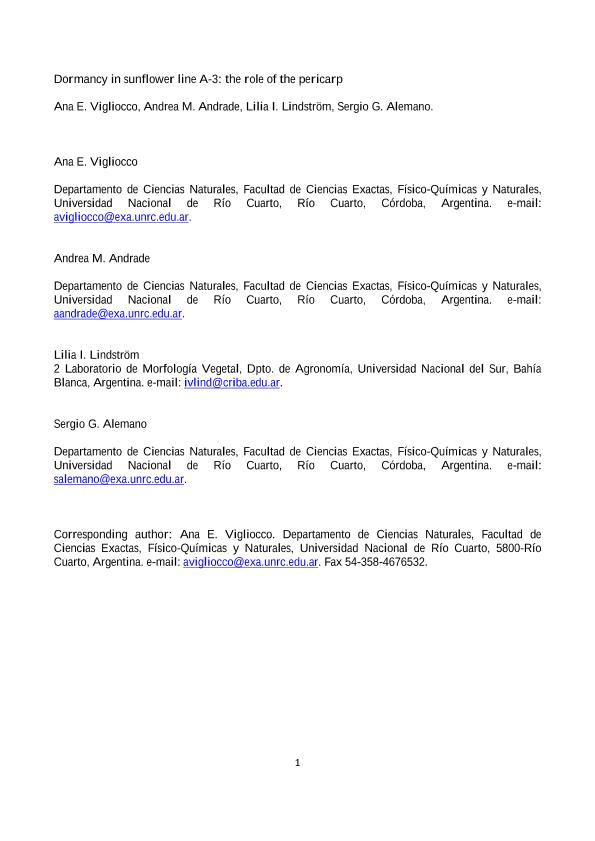Mostrar el registro sencillo del ítem
dc.contributor.author
Vigliocco, Ana Edit

dc.contributor.author
Andrade, Andrea Mariela

dc.contributor.author
Lindström, Lilia Ivone

dc.contributor.author
Alemano, Sergio Gabriel

dc.date.available
2021-05-20T17:47:05Z
dc.date.issued
2017-03
dc.identifier.citation
Vigliocco, Ana Edit; Andrade, Andrea Mariela; Lindström, Lilia Ivone; Alemano, Sergio Gabriel; Dormancy in sunflower line A-3: The role of the pericarp; Canadian Science Publishing; Botany; 95; 8; 3-2017; 853-858
dc.identifier.issn
1916-2804
dc.identifier.uri
http://hdl.handle.net/11336/132384
dc.description.abstract
Sunflower (Helianthus annuus L.) can often display seed dormancy, which causes a delay for immediate sowing. The final degree of “whole seed” dormancy is determined by the contributions of the tissues that comprise it, such as, embryo, seed coat, and (or) pericarp. The sunflower dormancy can be reduced during after-ripening and by removing seed constraints. Our objective was to study how the conditions of storage and removal of the pericarp affect the level of dormancy in line A-3. Also we provide insight on the basis of the morphological characteristics of A-3 pericarp-imposed dormancy. A germination test was conducted on dry cypselas with and without pericarp, at 30 and 70 days after harvest. For histological analysis, permanent slides of pericarp crosssections were obtained. The germination percentage showed significant differences between cypselas with intact pericarp (30 days after harvest = 26%; 70 days after harvest = 77%), and cypselas without pericarp (30 days after harvest = 65%; 70 days after harvest = 96%). This indicates that the pericarp plays an important role in regulating physical dormancy in the seed of sunflower line A-3, and that its relative contribution to the dormancy level is modified during after-ripening.
dc.description.abstract
Le tournesol (Helianthus annuus L.) peut souvent présenter un repos germinatif qui cause un délai de l’ensemencement immédiat. Le degré final de dormance de la graine entière est déterminé par les contributions des tissus qui la comprennent comme l’embryon, l’enveloppe de la graine et (ou) le péricarpe. La dormance du tournesol peut être réduite durant la période postmaturation et en retirant les contraintes de la graine. L’objectif des auteurs était d’étudier comment les conditions d’entreposage et le retrait du péricarpe affectent le niveau de dormance de la lignée A-3. Ils fournissent aussi un aperçu du fondement des caractéristiques morphologiques de la dormance de A-3 imposée par le péricarpe. Un test de germination a été réalisé sur des cypsèles sèches avec ou sans péricarpe à 30 et 70 jours après la récolte. Des lames permanentes de coupes transversales de péricarpes ont été obtenues aux fins d’analyse histologique. Les pourcentages de germination des cypsèles possédant un péricarpe intact (30 jours après récolte = 26 %; 70 jours après récolte = 77 %) et des cypsèles sans péricarpes (30 jours après récolte = 65 %; 70 jours après récolte = 96 %) étaient significativement différents. Cela indique que le péricarpe joue un rôle important dans la régulation du repos germinatif physique de la lignée de tournesol A-3 et que sa contribution relative au niveau de dormance est modifiée en période postmaturation.
dc.format
application/pdf
dc.language.iso
eng
dc.publisher
Canadian Science Publishing

dc.rights
info:eu-repo/semantics/openAccess
dc.rights.uri
https://creativecommons.org/licenses/by-nc-sa/2.5/ar/
dc.subject
AFTER-RIPENING
dc.subject
DORMANCY
dc.subject
HISTOLOGY
dc.subject
PERICARP
dc.subject
SUNFLOWER
dc.subject.classification
Otras Ciencias Biológicas

dc.subject.classification
Ciencias Biológicas

dc.subject.classification
CIENCIAS NATURALES Y EXACTAS

dc.title
Dormancy in sunflower line A-3: The role of the pericarp
dc.type
info:eu-repo/semantics/article
dc.type
info:ar-repo/semantics/artículo
dc.type
info:eu-repo/semantics/publishedVersion
dc.date.updated
2021-05-11T18:16:23Z
dc.journal.volume
95
dc.journal.number
8
dc.journal.pagination
853-858
dc.journal.pais
Canadá

dc.journal.ciudad
Otawa
dc.description.fil
Fil: Vigliocco, Ana Edit. Universidad Nacional de Rio Cuarto. Facultad de Ciencias Exactas Fisicoquímicas y Naturales. Cátedra de Fisiología Vegetal; Argentina. Consejo Nacional de Investigaciones Científicas y Técnicas. Centro Científico Tecnológico Conicet - Córdoba; Argentina
dc.description.fil
Fil: Andrade, Andrea Mariela. Universidad Nacional de Rio Cuarto. Facultad de Ciencias Exactas Fisicoquímicas y Naturales. Cátedra de Fisiología Vegetal; Argentina. Consejo Nacional de Investigaciones Científicas y Técnicas. Centro Científico Tecnológico Conicet - Córdoba; Argentina
dc.description.fil
Fil: Lindström, Lilia Ivone. Universidad Nacional del Sur. Departamento de Agronomía; Argentina
dc.description.fil
Fil: Alemano, Sergio Gabriel. Universidad Nacional de Rio Cuarto. Facultad de Ciencias Exactas Fisicoquímicas y Naturales. Cátedra de Fisiología Vegetal; Argentina
dc.journal.title
Botany

dc.relation.alternativeid
info:eu-repo/semantics/altIdentifier/url/https://cdnsciencepub.com/doi/10.1139/cjb-2016-0272
dc.relation.alternativeid
info:eu-repo/semantics/altIdentifier/doi/https://doi.org/10.1139/cjb-2016-0272
Archivos asociados
